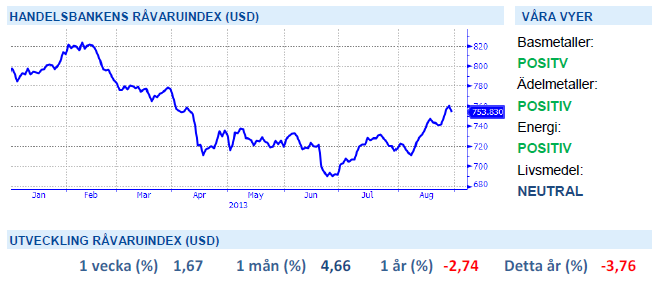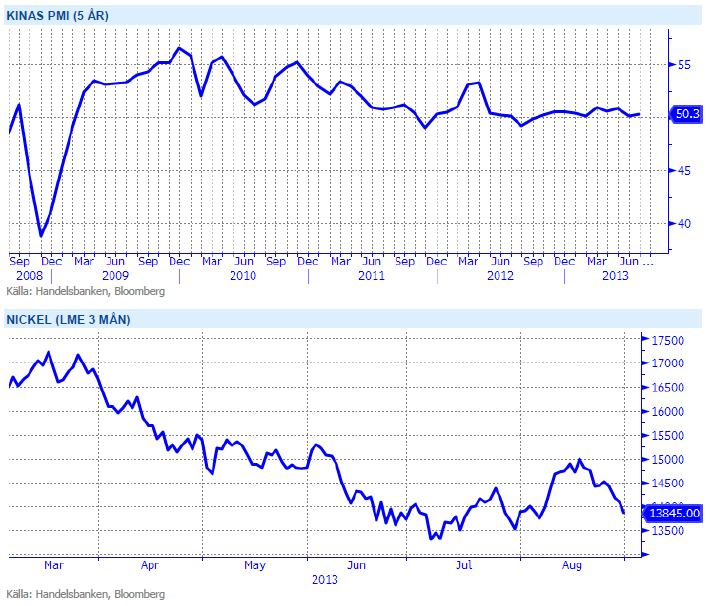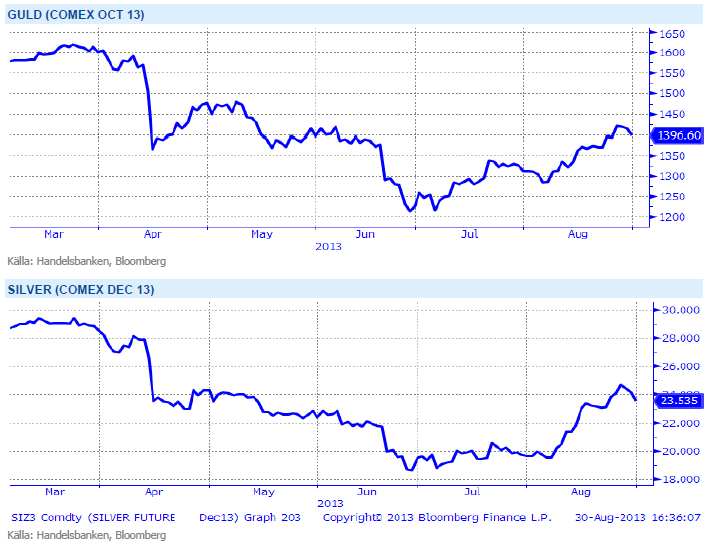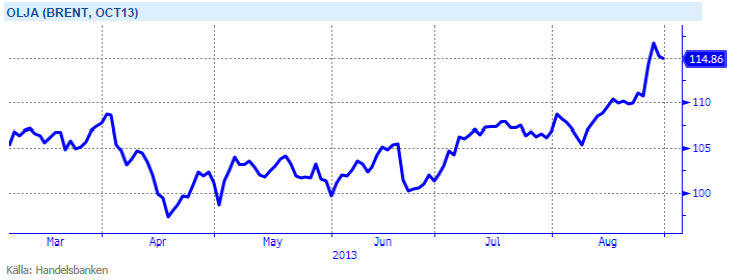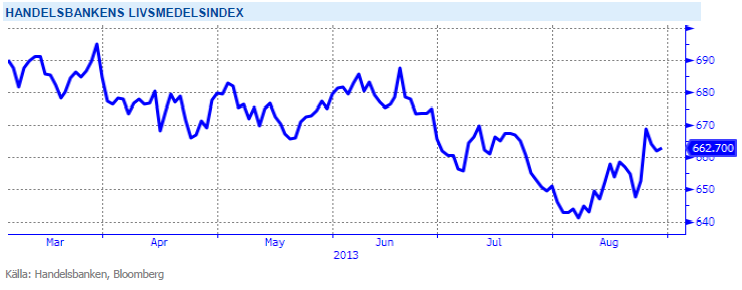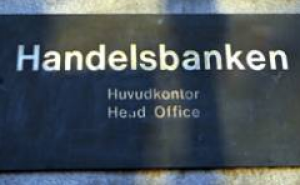Analys
SHB Råvarubrevet 30 augusti 2013
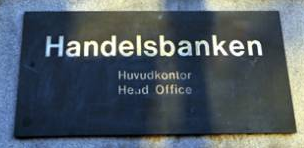
 Råvaror allmänt
Råvaror allmänt
Allt fokus på Syrien
USA tillsammans med Storbritannien och Frankrike laddar upp för någon slags militär intervention i syfte att straffa den syriska regimen för påstådda krigsförbrytelser, kanske i syfte att skicka en signal till andra länder att kemisk krigföring inte är acceptabelt. Detta har gett olja och guldpriset rejäl skjuts och bidragit till ökad volatilitet och sänkt riskaptit generellt på finansmarknaderna. Än så länge är det dock för tidigt att tala om några större negativa ekonomiska effekter från vad som hänt. Vad som händer framöver avgörs av vilka insatser som görs samt vilken respons det får, inte bara från Syriens regering utan även i omkringliggande länder och på ”den arabiska gatan”. Iraks oljeproduktion är den största riskfaktorn just nu. Den Sunni vs Shiite konflikt som råder i Syrien är direkt översättningsbar till Irak. Riskpremien i olja är därför motiverad då Irak, till skillnad från Syrien har en betydande oljeproduktion som Saudi inte kan täcka upp för.
Vårt positiva konjunkturscenario har getts stöd av den senaste statistiken, trots att amerikansk bostadsmarknadsdata på sistone överraskat något negativt. Risken för vissa ekonomiska bakslag senare i höst får sägas vara stigande givet att turbulensen i emerging markets i dagens marknad inte på något sätt tänks påverka varken Europa eller USA.
Basmetaller
I väntan på PMI från Kina
Basmetallerna har fallit något under veckan på den generella risk off rörelsen i bakvattnet av krigsrisken i Mellanöstern och som får industriella råvaror att backa medans klassiska krisindikator som guld och olja stiger. Vårt basmetallindex faller med 1,3 % där nickel återigen tar den största smällen, ner 4 %. Handelsdata, råvaruimport och flash PMI pekar all i rätt riktning för att Kinas makrodata ska kunna bli en otippad positiv överraskning under september.
På söndag publiceras Kinas PMI (det statliga) för augusti där förväntat 50,2 mot 50,3 i juli. HSBC:s PMI publiceras därefter på måndag där förväntat ligger på 50,2 mot 47,7 i juli. Vi räknar med positiv överraskning för dessa båda data vilket kommer driva basmetaller uppåt. Vi behåller vår positiva vy för basmetaller.
Nickel är den basmetall som gått ner mest under året och med många gruvor som går med förlust på dagens prisnivåer tror vi på stigande priser. Vi tror på: LONG NICKEL H
Ädelmetaller
Guld, fortsatt starkt, men platina ännu starkare
Guldet ligger i skrivande stund på samma nivå som förra veckan, 1395 dollar per uns. Förra veckan var det dock veckohögsta, denna veckan är det veckolägsta. Vi har varit uppe på 1430 dollar, drivet av John Kerrys uppskruvade retorik mot Syrien, men inga fundamentala nyheter har påverkat priset denna veckan. Vi tycker fortfarande att prisutvecklingen ser konstruktiv ut, och ligger kvar i vår positiva syn på guldet. Vi har haft 1450 som target i denna prisrörelse, och når vi dit så får vi ta en funderare på nästa steg.
I väntan på detta vill vi slå ett slag för en annan ädelmetall – platina – som inte bara får avsevärt mindre uppmärksamhet än guldet, utan också är något ”smartare” i betydelsen att den har en industriell nytta. Platina har faktiskt utpresterat guldet inte bara under guldets fall under våren, utan även under återhämtningen sedan halvårsskiftet. Vi har en positiv syn på hela ädelmetallsektorn, mest drivet av guldet, men kommer att titta lite närmare på platina framöver. Watch this space!
I ett läge där råvaror generellt har viktats ned av institutionella placerare kan guld och silver få en ”omotiverad” uppgång när dessa indexköpare återvänder till råvaror drivit av bättre utsikter för Kina och USA. Vi tror på: LONG GULD H och LONG SILVER H
Energi
Syrien pressar upp oljepriset
Brentoljan handlades upp på högsta nivån (USD 116.61) sedan februari efter oro kring ytterligare utbudsstörningar i Mellanöstern om västvärlden skulle intervenera i Syrien. Detta utöver rådande MENA oro och produktionsbortfall om ca 2.8 miljoner fat per dag under augusti främst från Iran och Libyen men även från Syrien, Sudan och Irak. Trenden förstärks ytterligare av globala tillväxtförväntningar. Ett ökat intresse för olja som aktiehedge skapar också momentum där marknaden blivit betydligt längre. Saudiarabien producerar närmare 10.5 miljoner fat per dag, den högsta nivån någonsin, vilket resulterar i en global reservkapacitet om endast 1.3 miljoner fat per dag vs USA:s skifferproduktion om 2.5 miljoner fat per dag. De globala utbudsstörningarna har ökat 3 miljoner fat per dag sedan december 2009 att jämföra med tillväxten i USA:s skifferproduktion om 2 miljoner fat per dag under samma period. Med kraftiga utbudsstörningar och låg reservkapacitet kan oljepriset med andra ord skjuta ordentligt i höjden vid en eventuell intervention i Syrien. Oavsett om det sker eller inte räknar vi med ett fortsatt högt oljepris med klar potential på uppsidan. Mer om utvecklingen på oljemarknaden.
Elmarknaden och kvartalet Q413 backar med strax över en procent efter att väderprognoserna tappat den torra avslutning som låg mot slutet av förra veckan. Nederbörden ser ut att gå mer mot normala nivåer vilket skulle innebära ett underskott kring ca 8-9 TWh efter vecka 36. Då gas får stöd av oljemarknaden samtidigt som utsläppsrätterna och kolet handlar oförändrat. Även om kolsentimentet försvagats något ytterligare i fronten, förväntar vi oss att elmarknaden handlar kvar i den range vi fastnat i med risken på uppsidan om vädret slår om mot det torrare slaget igen.
Oroligheterna i mellanöstern med risk för ytterligare produktionsbortfall ger stöd till oljepriset. Vi tror på: LONG OLJA
Livsmedel
Vädret i fokus
Vädret fortsätter att styra prisutvecklingen för vete, majs och sojabönor. Vete och majs steg i början av veckan men efter att regn (dock inga stora mängder) fallit över viktiga regioner i USA handlas grödorna nu på samma nivåer som måndagens öppning. Priset på sojabönor har rört sig sidledes under veckan och stänger något lägre (-1,4 %). Vi fortsätter att hålla neutral vy för denna sektor och konstaterar att väderprognoserna kommer stå i fokus ett tag framöver.
Det är fortfarande torrt vid Elfenbenskusten varför priset på kakao gått sidledes de senaste tre veckorna. Det var i början av augusti som priset på kakao steg 7 procent efter uteblivet regn. Västafrika står för 70 procent av den globala kakaoproduktionen och risken på uppsidan ökar i takt med fortsatt torka i dessa regioner. Kaffepriset fortsätter att backa och i skrivande stund handlas decemberkontraktet på 1,17 dollar/Ib. Årets skörd har hittills inte visat på några större överraskningar och det rapporteras om goda lager. Fler och fler odlare håller på sitt kaffe som följd av de låga kaffepriserna och hoppas på stigande priser.
Handelsbankens Råvaruindex
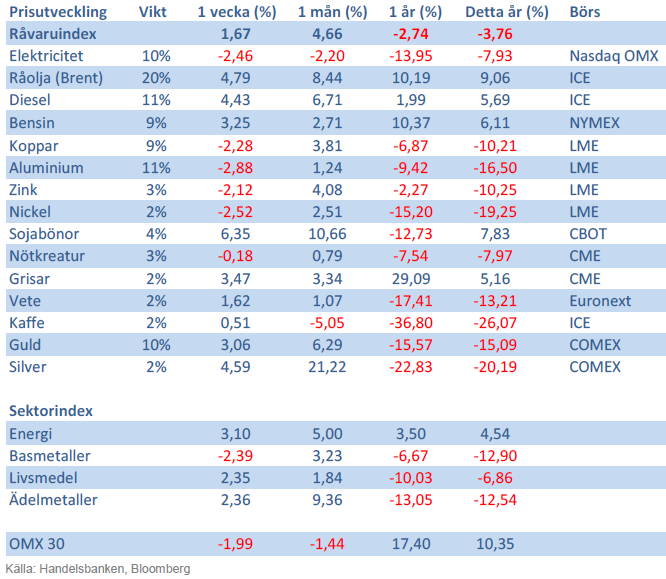
Handelsbankens råvaruindex består av de underliggande indexen för respektive råvara. Vikterna är bestämda till hälften från värdet av nordisk produktion (globala produktionen för sektorindex) och till hälften från likviditeten i terminskontrakten.
[box]SHB Råvarubrevet är producerat av Handelsbanken och publiceras i samarbete och med tillstånd på Råvarumarknaden.se[/box]
Ansvarsbegränsning
Detta material är producerat av Svenska Handelsbanken AB (publ) i fortsättningen kallad Handelsbanken. De som arbetar med innehållet är inte analytiker och materialet är inte oberoende investeringsanalys. Innehållet är uteslutande avsett för kunder i Sverige. Syftet är att ge en allmän information till Handelsbankens kunder och utgör inte ett personligt investeringsråd eller en personlig rekommendation. Informationen ska inte ensamt utgöra underlag för investeringsbeslut. Kunder bör inhämta råd från sina rådgivare och basera sina investeringsbeslut utifrån egen erfarenhet.
Informationen i materialet kan ändras och också avvika från de åsikter som uttrycks i oberoende investeringsanalyser från Handelsbanken. Informationen grundar sig på allmänt tillgänglig information och är hämtad från källor som bedöms som tillförlitliga, men riktigheten kan inte garanteras och informationen kan vara ofullständig eller nedkortad. Ingen del av förslaget får reproduceras eller distribueras till någon annan person utan att Handelsbanken dessförinnan lämnat sitt skriftliga medgivande. Handelsbanken ansvarar inte för att materialet används på ett sätt som strider mot förbudet mot vidarebefordran eller offentliggörs i strid med bankens regler.
Analys
Tightening fundamentals – bullish inventories from DOE

The latest weekly report from the US DOE showed a substantial drawdown across key petroleum categories, adding more upside potential to the fundamental picture.

Commercial crude inventories (excl. SPR) fell by 5.8 million barrels, bringing total inventories down to 415.1 million barrels. Now sitting 11% below the five-year seasonal norm and placed in the lowest 2015-2022 range (see picture below).
Product inventories also tightened further last week. Gasoline inventories declined by 2.1 million barrels, with reductions seen in both finished gasoline and blending components. Current gasoline levels are about 3% below the five-year average for this time of year.
Among products, the most notable move came in diesel, where inventories dropped by almost 4.1 million barrels, deepening the deficit to around 20% below seasonal norms – continuing to underscore the persistent supply tightness in diesel markets.
The only area of inventory growth was in propane/propylene, which posted a significant 5.1-million-barrel build and now stands 9% above the five-year average.
Total commercial petroleum inventories (crude plus refined products) declined by 4.2 million barrels on the week, reinforcing the overall tightening of US crude and products.


Analys
Bombs to ”ceasefire” in hours – Brent below $70

A classic case of “buy the rumor, sell the news” played out in oil markets, as Brent crude has dropped sharply – down nearly USD 10 per barrel since yesterday evening – following Iran’s retaliatory strike on a U.S. air base in Qatar. The immediate reaction was: “That was it?” The strike followed a carefully calibrated, non-escalatory playbook, avoiding direct threats to energy infrastructure or disruption of shipping through the Strait of Hormuz – thus calming worst-case fears.

After Monday morning’s sharp spike to USD 81.4 per barrel, triggered by the U.S. bombing of Iranian nuclear facilities, oil prices drifted sideways in anticipation of a potential Iranian response. That response came with advance warning and caused limited physical damage. Early this morning, both the U.S. President and Iranian state media announced a ceasefire, effectively placing a lid on the immediate conflict risk – at least for now.
As a result, Brent crude has now fallen by a total of USD 12 from Monday’s peak, currently trading around USD 69 per barrel.
Looking beyond geopolitics, the market will now shift its focus to the upcoming OPEC+ meeting in early July. Saudi Arabia’s decision to increase output earlier this year – despite falling prices – has drawn renewed attention considering recent developments. Some suggest this was a response to U.S. pressure to offset potential Iranian supply losses.
However, consensus is that the move was driven more by internal OPEC+ dynamics. After years of curbing production to support prices, Riyadh had grown frustrated with quota-busting by several members (notably Kazakhstan). With Saudi Arabia cutting up to 2 million barrels per day – roughly 2% of global supply – returns were diminishing, and the risk of losing market share was rising. The production increase is widely seen as an effort to reassert leadership and restore discipline within the group.
That said, the FT recently stated that, the Saudis remain wary of past missteps. In 2018, Riyadh ramped up output at Trump’s request ahead of Iran sanctions, only to see prices collapse when the U.S. granted broad waivers – triggering oversupply. Officials have reportedly made it clear they don’t intend to repeat that mistake.
The recent visit by President Trump to Saudi Arabia, which included agreements on AI, defense, and nuclear cooperation, suggests a broader strategic alignment. This has fueled speculation about a quiet “pump-for-politics” deal behind recent production moves.
Looking ahead, oil prices have now retraced the entire rally sparked by the June 13 Israel–Iran escalation. This retreat provides more political and policy space for both the U.S. and Saudi Arabia. Specifically, it makes it easier for Riyadh to scale back its three recent production hikes of 411,000 barrels each, potentially returning to more moderate increases of 137,000 barrels for August and September.
In short: with no major loss of Iranian supply to the market, OPEC+ – led by Saudi Arabia – no longer needs to compensate for a disruption that hasn’t materialized, especially not to please the U.S. at the cost of its own market strategy. As the Saudis themselves have signaled, they are unlikely to repeat previous mistakes.
Conclusion: With Brent now in the high USD 60s, buying oil looks fundamentally justified. The geopolitical premium has deflated, but tensions between Israel and Iran remain unresolved – and the risk of missteps and renewed escalation still lingers. In fact, even this morning, reports have emerged of renewed missile fire despite the declared “truce.” The path forward may be calmer – but it is far from stable.
Analys
A muted price reaction. Market looks relaxed, but it is still on edge waiting for what Iran will do

Brent crossed the 80-line this morning but quickly fell back assigning limited probability for Iran choosing to close the Strait of Hormuz. Brent traded in a range of USD 70.56 – 79.04/b last week as the market fluctuated between ”Iran wants a deal” and ”US is about to attack Iran”. At the end of the week though, Donald Trump managed to convince markets (and probably also Iran) that he would make a decision within two weeks. I.e. no imminent attack. Previously when when he has talked about ”making a decision within two weeks” he has often ended up doing nothing in the end. The oil market relaxed as a result and the week ended at USD 77.01/b which is just USD 6/b above the year to date average of USD 71/b.

Brent jumped to USD 81.4/b this morning, the highest since mid-January, but then quickly fell back to a current price of USD 78.2/b which is only up 1.5% versus the close on Friday. As such the market is pricing a fairly low probability that Iran will actually close the Strait of Hormuz. Probably because it will hurt Iranian oil exports as well as the global oil market.
It was however all smoke and mirrors. Deception. The US attacked Iran on Saturday. The attack involved 125 warplanes, submarines and surface warships and 14 bunker buster bombs were dropped on Iranian nuclear sites including Fordow, Natanz and Isfahan. In response the Iranian Parliament voted in support of closing the Strait of Hormuz where some 17 mb of crude and products is transported to the global market every day plus significant volumes of LNG. This is however merely an advise to the Supreme leader Ayatollah Ali Khamenei and the Supreme National Security Council which sits with the final and actual decision.
No supply of oil is lost yet. It is about the risk of Iran closing the Strait of Hormuz or not. So far not a single drop of oil supply has been lost to the global market. The price at the moment is all about the assessed risk of loss of supply. Will Iran choose to choke of the Strait of Hormuz or not? That is the big question. It would be painful for US consumers, for Donald Trump’s voter base, for the global economy but also for Iran and its population which relies on oil exports and income from selling oil out of that Strait as well. As such it is not a no-brainer choice for Iran to close the Strait for oil exports. And looking at the il price this morning it is clear that the oil market doesn’t assign a very high probability of it happening. It is however probably well within the capability of Iran to close the Strait off with rockets, mines, air-drones and possibly sea-drones. Just look at how Ukraine has been able to control and damage the Russian Black Sea fleet.
What to do about the highly enriched uranium which has gone missing? While the US and Israel can celebrate their destruction of Iranian nuclear facilities they are also scratching their heads over what to do with the lost Iranian nuclear material. Iran had 408 kg of highly enriched uranium (IAEA). Almost weapons grade. Enough for some 10 nuclear warheads. It seems to have been transported out of Fordow before the attack this weekend.
The market is still on edge. USD 80-something/b seems sensible while we wait. The oil market reaction to this weekend’s events is very muted so far. The market is still on edge awaiting what Iran will do. Because Iran will do something. But what and when? An oil price of 80-something seems like a sensible level until something do happen.
-

 Nyheter4 veckor sedan
Nyheter4 veckor sedanMahvie Minerals växlar spår – satsar fullt ut på guld
-

 Analys4 veckor sedan
Analys4 veckor sedanA muted price reaction. Market looks relaxed, but it is still on edge waiting for what Iran will do
-

 Nyheter3 veckor sedan
Nyheter3 veckor sedanJonas Lindvall är tillbaka med ett nytt oljebolag, Perthro, som ska börsnoteras
-

 Nyheter3 veckor sedan
Nyheter3 veckor sedanOljan, guldet och marknadens oroande tystnad
-

 Nyheter3 veckor sedan
Nyheter3 veckor sedanDomstolen ger klartecken till Lappland Guldprospektering
-

 Analys3 veckor sedan
Analys3 veckor sedanTightening fundamentals – bullish inventories from DOE
-

 Nyheter2 veckor sedan
Nyheter2 veckor sedanRyska staten siktar på att konfiskera en av landets största guldproducenter
-

 Nyheter2 veckor sedan
Nyheter2 veckor sedanSommarvädret styr elpriset i Sverige


